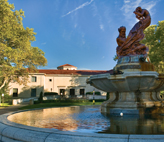Curriculum & Training
The PhD program is designed to foster both intellectual and professional growth. The curriculum not only trains for area specialization but for intellectual breadth: we expect our students to ask significant questions that will interest scholars and students in a variety of fields inside and outside the discipline. Our new program of research constellations is designed to spur this kind of significant and innovative inquiry.
Graduate students will work closely with faculty to insure that they acquire foundational knowledge of artistic production in an historical and geographical area, but will assemble dissertation committees from the research constellations in which faculty operate. The goal is to produce work that displays command over a particular historical and geographical area, and at the same time contributes to the ideas that give life to the department’s constellations. Curriculum requirements and teaching assistantships also give students the opportunity to study and learn broadly, and they are expected to study outside the History of Art and Architecture department to begin framing the kind of interdisciplinary questions that both teaching and scholarship increasingly demand.
Our program also places an early emphasis on pedagogy and the cultivation of a strong teach portfolio. We expect every one of our graduates, for example, to be able to teach a college-level introduction to world art. We are also highly attentive to the professionalization of our graduate student scholars, and we expect all of them to graduate with a substantial cv. The department offers workshops, courses, and mentoring on both proposal writing and grant writing. Recent PhD students have placed their work in publications such as Athanor, Nineteenth Century Art Worldwide, and October, and have won external grants from the Fulbright, DAAD, Japan Foundation, CCK Foundation, and Metropolitan Museum.

